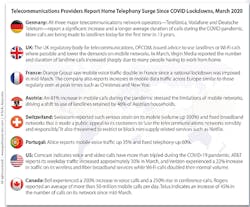"It’s good to hear your voice" expresses gratitude for human connection when it’s needed most. During the COVID-19 pandemic, people around the globe are reaching out via voice calls from home in unprecedented numbers. The combination of work-from-home, school-from-home, and other new hyphenated- from-home lifestyles, have driven dramatic upticks in voice calling in all its forms, according to the world’s leading telecommunications providers.
Recognizing some trends are temporary while others may signal lasting change, this market snapshot explores how home telephony is transforming in ways that provide renewed validation of legacy technologies even while new technologies accelerate adoption. Deprived of direct physical presence, households find voice calls address the universal need for communication and social connection, providing a lifeline for everyday life, work, and relationships.
Drivers and Use Cases
A convergence of drivers and use cases that make general calling attractive, and specific modes of calling preferable, is driving the current calling spike.
• Social Isolation — Households have turned to voice calling to maintain relationships with family and friends, check on the elderly and on children away at school, or with those in hotspots. Any organization without a robust digital presence, from religious communities to schools, has relied on voice calls to serve its constituencies.
• Work From Home (WFH) — The recent necessity of remote workers, either mandated by local ordinances or voluntarily adopted by companies, has accelerated a movement that was well underway. WFH has shifted the burden of telecommunications from the office to the home, competing now with every other personal use of home networks. Video conferencing apps — Zoom, Microsoft Teams, GoToMeeting, RingCentral, and Google Meet — are enabling WFH employees by enhancing traditional voice calling with video conferencing, screen sharing, IM/chat, and other collaboration tools. Businesses are commissioning enterprise telephony hardware, from headsets to desktop office phones, for home use.
• Healthcare Needs — With closure of physicians’ offices, use of telehealth services nearly tripled in the US between April 2019 and May 2020. Almost half of telehealth contacts were with local physicians. US telehealth services specifically by phone increased 170% YOY as phone calls remain the dominant telehealth modality.
• Elder Care and the Vulnerable — Elders and the vulnerable at high risk to both COVID-19 and social isolation turn to voice calls for safety and access to critical services. A UK call center for personal emergency alert (PERS) systems serving the elderly has seen a 14% increase in emergency calls since the COVID-19 crisis began. In the US, 911 emergency calls are most reliable and specific when landlines associated with an established physical location are used.
InvisiLight® Solution for Deploying Fiber
April 2, 2022Go to Market Faster. Speed up Network Deployment
April 2, 2022Episode 10: Fiber Optic Closure Specs Explained…
April 1, 2022Food for Thought from Our 2022 ICT Visionaries
April 1, 2022Changes in Residential Calling Technologies
While legacy copper lines enabled landline voice calling for a century and a half, today’s residential voice calls take 3 forms:
1. Traditional Fixed-Line
As service providers and government officials expressed public concern over network capacity and resilience, German handset manufacturer Gigaset reports many consumers in certain European regions upgraded their fixed-line telephones to ensure a reliable backup system was in place. Households that had a working fixed-line in place due to bundling with broadband service, even though unused, purchased updated fixed-line phones. Gigaset reports sales of its DECT fixed-line phones and VoIP headsets from its online shop grew by 400% during the first few weeks of lockdowns.
2. VoIP
Sales of Wi-Fi and DECT USB sticks increased by 20-70% depending on model. Telephony manufacturer Snom reports a new phenomenon of workers taking their office desktop IP phones home with them for the benefits of audio quality, speaker phone features, integrated contact lists, and line-switching capabilities. Similarly, Jabra reports a major uptick in sales of headsets and headphones that created backorders for many models.
In recent years, most traditional fixed-line networks have been migrating to IP networking infrastructure first for businesses and secondly for consumers.
• Swisscom and Deutsche Telekom report they have completed their massive migration projects in all the regions they serve. Orange is well underway.
• BT has plans to complete migrations by 2025.
• In the US, AT&T and Verizon have been replacing copper lines with fiber optic cable but remain several years away from full migration.
Unified communication platforms have emerged that integrate multimodal forms of communication, including voice, video, chat, screen sharing, and collaborative features. During the COVID-19 pandemic, popular and new B2B video conferencing services have introduced droves of residential households to their capabilities.
3. Mobile-Only Households
In the US today there are also almost 16 million mobile-only households, whose only broadband access to the Internet is through a mobile data plan. Mobile-only homes are most popular among young adults and renters. Italy has almost 6 million mobile-only households, accounting for almost 1 in 4 homes.
The Future of Home Telephony
Whether the COVID-19 crisis alone has lasting effects on home telephony, it has accelerated trends already in play and underscored the invaluable place for voice calling in all its forms.
Landlines will continue migration to support all manner of VoIP calls. For some households, this experience may reinforce a commitment to retain landlines as a reliable backup when networks are overburdened, just as people now purchase generators and other self-sustaining equipment.
The future of fixed-line telephony enabled by IP technology will include features such as:
• Simultaneous ringing on mobile and landline phones.
• Simpler call diversion from fixed office lines to mobile or residential landlines.
• Landline number used for mobile calling.
• Enhanced call filters to block unwanted advertising and anonymous calls.
• Ability to run multiple phone lines across a single broadband link.
Many companies already forecast a reduction in office footprints as they plan to permanently shift to models with a larger share of work-from-home employees. As the enterprise and home converge, solutions that deliver high-quality, reliable voice calling will be increasingly in demand. Consumer electronics trends also suggest wireless peripherals will see wider adoption for calling.
A renewed concern for the elderly, vulnerable, and socially isolated, will drive appreciation of technologies that keep loved ones connected, cared for, and safe. Telemedicine, remote patient monitoring, and independent living solutions, will all require telephony support.
Like this Article?
Subscribe to ISE magazine and start receiving your FREE monthly copy today!
Service providers and regulators will be wise to consider how fixed-line calling (traditional and VoIP) continues to figure significantly in long-term network strategy, and how new service bundles might serve the emerging work-from-home and eldercare markets.
Regardless of the transformation coming, it will always be good to hear someone’s voice.
Resources and Notes
To learn more about the white paper Voice as a Lifeline and the Transformation of Home Telephony, visit http://www.parksassociates.com/whitepapers/landline-2020.
About the Author






